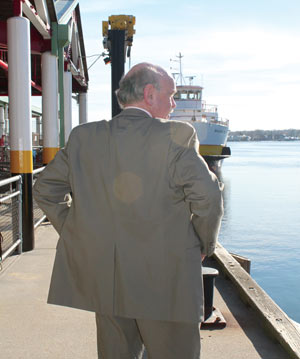February/March 2011
By Robert Witkowski
Stepping down after a decade as city manager, Joe Gray reflects on Portland’s startling changes since he arrived here from Madison, Wisconsin, 41 years ago.
Our toil’s obscure and a’ that
The rank is but the guinea’s stamp
The man’s the gowd for a’ that
What though on hamely fare we dine
Wear hoddin grey, an’ a’ that
Gie fools their silks, and knaves their wine
A man’s a man, for a’ that
For a’ that, an’ a’ that
Their tinsel show an’ a’ that
The honest man, though e’er sae poor
Is king o’ men for a’ that
From “A Man’s A Man For A’ That,” Robert Burns,1797
 If your career were a movie, give us the trailer.
If your career were a movie, give us the trailer.
The most difficult call I ever got was in the middle of the night from Jeff Monroe after 9-11, telling me it appeared two of the terrorists started their day in Portland. Sometime in the morning–I think it was 3 a.m.–I found myself standing there, watching these two guys going up the escalator on tape. They looked just like any young businessmen in their 30s, talking, and you knew they knew they’d be dead in three hours. It woke me up to the intense feelings people have.
On that note, didn’t you fire Monroe as Portland’s Director of Ports & Transportation in May 2008?
Well, not just Jeff. It was a difficult decision in a tough budget year. We had to make lots of cutbacks equally significant. We also eliminated the head of Parks & Rec and many other positions… There was some adjusting, but nothing that led to interruption of services.
Did Portland save a lot by collapsing the Monroe position and its support functions?
Oh, God, yeah! We saved $300,000 annually. We were able to turn the International Marine Terminal over to the state, and we got out of the Capital Fund. The fire chief is responsible for all of our Homeland Security; the Harbor Commission, made up by Portland and South Portland, continues its operations; and cruise ships are handled by a private contractor who negotiates with the cruise lines.
What’s the most unfair criticism you’ve had?
I didn’t have enough visibility. It’s probably the comment I’ve most heard over time.
Not that you’re Mr. Cellophane! Ocean Gateway is a wonderful step toward the future.
Ocean Gateway was part of a broader plan for the eastern part of the waterfront. And had all the elements been carried out, how it would have fit into that plan would have been very visible to the community. Because so much of that other plan has floundered due to the economy, Ocean Gateway stands out there by itself. People are impatient after three or four years. The reality is, these are 10- to 20-year redevelopments.
The new megaberth will handle virtually all cruise ships in operation, and we’ll be in position for the next generation of ships coming. Homeberthing here would be a big boost. But you have to take the long view, like Bayside [neighborhood].
It’s a disappointment to lose the ferry [to Nova Scotia], but it’s my understanding that sometime in 2012 we will have some service.
As a property owner on Peaks, were you more or less sympathetic to the secessionist movement?
We bought our place on Peaks Island shortly after we moved here in the 1970s. I certainly understand the feeling that the island is unique; nonetheless, it is a neighborhood of the city, and all neighborhoods feel they are unique. As a city, there are trade-offs between neighborhoods–you don’t get everything you want.
Look at the East End–we had to close a branch of the library. You can’t say the East End is going to secede. I understand Peaks’s uniqueness, but to me it is part of the city.
What‘s the biggest difference in the city now compared to when you began at City Hall, after coming from University of Wisconsin in 1969 with your master’s in hand?
Diversity of population and the transformation of downtown with real estate and the arts and culture, which are so important to the downtown.
You don’t mean the arrival of L.L. Bean and the Portland Public Market? Those great victories now seem like challenging losses.
The reality is, we’ve got Renys taking both Olympia Sports and L.L. Bean’s space. Renys has a long tradition of locating and serving downtown markets. It’s actually very exciting. This is not going to be a long-time gap, which was a concern.
The Public Market is really on the fringe of the Arts District, so it was certainly a disappointment but more for Bayside redevelopment. We were worried after the voters turned down the library’s relocation there. We’re talking about a rather large space–25,000 square feet in a uniquely designed building. But at the end of the day, we were able to work quickly for successful reuse [by PowerPay] that brought a considerable number of jobs.
You were with the Redevelopment Authority when Reiche School & Community Center was built. With 20/20 hindsight, how successful was urban renewal in the West End?
I think in the long run, things have worked out. We are what I call a “Slow-Growth Community.” We are very much a consensus community and get neighborhood input; that was not the case when I came here. Development was based on a few people sitting with the city council making decisions on what was or wasn’t good for the city.
I think what helped change that was the Models Cities Program. It encouraged very significant citizen input and really helped start a lot of the neighborhood organizations that exist today in terms of wanting some input on how their neighborhoods get shaped. That’s had a very positive impact on the city. Overall, the design quality of what’s been built here has been sensitive to the historic character of the city–beyond criticism for the regulations.
Relate an experience or situation where you’ve thought, “Only in Portland…”
Moose running through the streets! The police and public works were calling me with updates as they were tracking the moose, not only through Deering Oaks but all the way up Brighton [Avenue].
What would you most like to see happen in Portland?
The Bayside area [developed] with a grander plan, and the waterfront vision realized. I’m proud of the work we did with the East End and waterfront in terms of the master plan, but it’s also one of my biggest frustrations. A lot of the things the plan advocated were approved but not able to be built because of the great recession.
We’ve come full circle with the working waterfront–from the Karen Sanford days of protecting maritime businesses with a waterfront referendum in the 1980s to the recent decision to repeal some of these restrictions. Taking the long view, what are your thoughts about that?
I don’t think it’s undoing [restrictions]–as opposed to many, many ports, most of the waterfront property is privately owned–it’s recognizing what’s always been an issue over the last 30 or 40 years: how to achieve an economic balance that protects the traditions of the working waterfont as it relates to fishing and lobstering and yet recognizes the need of pier owners to reach a level of return on their investments so they can reinvest in the piers and wharfs.
But pier owners, and even the lobstermen who were concerned about being displaced, admitted there are significant vacancies in the buildings on the piers–25 percent up to 45 percent–[and] they recognized the need to encourage investment.
Is that struggle with losing fishing boats due to Federal regulations shortening time out at sea, forcing boats to other ports so the fishing grounds are closer to “home”?
Oh, yeah, I think that certainly impacted it. On the other hand, I sit on the Fish Pier Authority, and the feeling is in a couple years the fishing stock may be replenished and we may see some degree of relaxation in many of those regulations that will help us.
What decision would you reverse with today’s hindsight?
Some budget decisions on operations–snow operations and trash collections operations–where clearly it gets back to the impact of what you see on the streets.
What best represents the city to you?
Certainly Portland Observatory. Longfellow Square is very meaningful to me, and Casco Bay Lines is another feature.
Traveling outside Maine, what’s the perception of Portland?
We’re an isolated community somewhere near the Arctic Circle with an endless winter.
What did you do that was most “John Menario-like” and what did you do that was most “Tim Honey-like”?
John was the first manager when I came here. He was instrumental in urban renewal and downtown redevelopment work.
A.J. Wilson was responsible for the first expansion of the Jetport.
Tim was A.J.’s assistant, and he undertook making the waterfront a priority–he took the first look at a master plan.
Bob Ganley had to deal with the transformation of downtown due to the loss of retail base and look at other options. We had the Downtown Master Plan that called for creation of the Arts District. So some of the foundation for that transformation was done during Bob’s tenure but continued under mine in terms of actually seeing it happen.
With the exception of A.J.–he’d been a deputy mayor in St. Louis and was the only one you could say came “from away”–the tradition of city managers going back to the mid-1960s has been local. I don’t consider Bob “from away”since he was city manager in South Portland and came over to Portland. It will be interesting as [the city council and mayor] go through this [selection] process on whether the new city manager will be local or “from away.”
Tim is still in the community, over on Bradley Street. He does a lot of international work and community development in African countries.
We’ve tried to keep business in Portland with tax increment financing (TIF). But we’ve seen UNUM, for instance, switch their headquarters to Chattanooga in spite of this. What are your thoughts about TIFs as a public financing method used to promote commercial and industrial development?
They moved their headquarters, but UNUM maintains a significant presence. We need to be judicious when we give TIFs–what will the financial arrangement between the organization asking for the TIFs and the city be, and what financial return will be given back to the city.
There’s criticism about [the TIF] keeping Pierce Atwood [from leaving Portland by decreasing their taxes], but [the site of their new offices at 258 Commercial Street], as it was, over the life of the TIF, would’ve generated only $640,000 in taxes. Under the arrangement with Pierce Atwood in that building, the city is getting more than $2.8 million.
It’s hard to see the Guy Gannett building on 390 Congress Street looking so lonely now, when it was once such a nerve center–our Daily Planet. Did you offer inducements for them to remain on the peninsula as owner/occupants?
The new owners [of the Press Herald] had excess space in their South Portland printing facility, and we knew there were internal discussions about moving all their operations–including news operations and corporate offices–to the South Portland plant, and we did not want to see that occur. We had discussions with Richard Connor and other senior leadership. Not that the city offered them anything–we didn’t–but we impressed upon them the importance we felt about the newspaper keeping a presence in Portland. I don’t know how persuasive our arguments were, but I guess the proof in the pudding is they maintained a significant presence, albeit in a much better space.
Did your bouts with cancer over the last few years have anything to do with your retirement?
No, I’m in full remission, so they tell me. I go every six moths for checkups. It really had nothing to do with it; it’s strictly a personal decision my wife and I made:
For our 40th anniversary, my wife and I went to Greece last October. We were staying with friends on the island of Rhodes. She’d been retired 18 months. We talked about if the time was right for me, and we came to the conclusion while sipping wine and looking at the Aegean Sea.
What is your personal opinion of the elected-mayor structure voted in recently by Portland citizens?
I don’t think we needed it. The present system works well. The reality is, the manager is still the CEO of the city and will carry the full responsibilities I had–none of that changes. [The manager will be appointed by the mayor], but it’s still a council decision, and the council needs to be comfortable not only with the day-to-day operations of the city but also with the intangibles: There is a chemistry that needs to exist between the manager and the council, a level of confidence and trust in each other. In terms of the mayor, [the new city manager and the mayor] are going to have to work that out between them. The charter envisions the mayor being the spokesperson for the city and laying out a plan for the city, but the manager still has all the day-to-day responsibilities.
What do you feel are your most significant achievements as city manager over the past decade?
My work on the East End waterfront–I take pride in the framework we were able to set up for that development; the work in Bayside, which started when I was in the planning office and is now a goal of the [Downtown Portland Corporation] and Economic Development Department; and I’m ultimately very pleased with the shoreway access plan [created] with Portland Trails.
There’s Ocean Gateway terminal, of course, and the growth of the cruise ship industry here.
I also feel the transportation initiatives such as the airport expansion and its level and frequency of service are impressive for a city of this size. Visiting relatives in Lincoln, Nebraska, I was struck that a city roughly three times the size of Portland only had two airlines!
What’s your favorite restaurant?
We live on State Street, so right now, one of our favorites is Local 188. We go there a lot. Espo’s is a favorite spur-of-the-moment place. When we are on the ferry, another spur-of-the-moment for seafood is Gilbert’s Chowder House.
We enjoy the Regency’s Armory lounge for a drink at night, and it’s a very pleasant atmosphere. In the summer we really like going to Portland Harbor Hotel’s garden lounge. It’s a really pleasant place to have a drink and relax.
Are you running for Mayor?
(Laughs) No.
What would your 2011 self say to your 1969 self?
It was worth the ride!





0 Comments